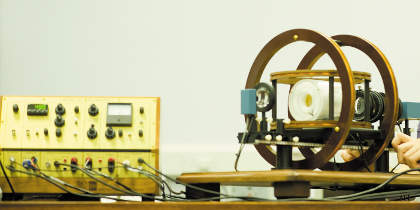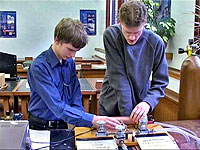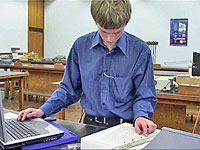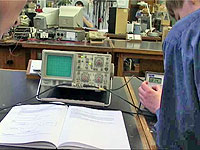
July 31, 2004, by Teaching at Nottingham
Teaching a physics laboratory module to blind students
Janette Dunn and Lara Meredith:
Background:
“Disability Legislation finally made its way into Higher Education in September 2002 in the form of the Special Educational Needs and Disability Act (SENDA or Part IV of the Disability Discrimination Act).
“With this change there was a need to improve staff awareness of the ways they could provide support for disabled students. The University of Nottingham was successful in securing HEFCE funding for the MMM project (Models, Methods and Materials; Departmental Strategies for Supporting Disabled Students). This project aims to enable staff to make simple changes to their teaching which will help disabled students and to publicise these achievements. In this way we hope all staff will be encouraged to take the lead in improving provision for disabled students.
“The example below demonstrates that with a little ingenuity and a willingness to learn disabled students can be included in a wide variety of learning situations.
Situation:
“Two blind students (M & Y) took a Physics course with a compulsory laboratory element. Both students read braille and use screen reading software. Neither read enlarged text. Despite this being the first time anyone in the School of Physics and Astronomy had taught Visually Impaired Students we overcame difficulties by being flexible and discussing solutions with the students.
Potential Problems and Solutions:
- Health and Safety Issues
Potential Problem: A blind student would be unaware of potential dangers.
Solution: Safety Officer to discuss safety issues in advance.As the students may have been unaware of potential dangers in the laboratory, the safety officer went through the safety issues with M & Y individually before their first lab session. In fact there was a fire alarm during M’s first lab session. He appeased any fears the staff may have had as he left the building without delay or undue assistance. - Class management
Potential Problem: Would a sighted lab partner become an assistant to a blind student?
Solution: The ideal solution is to have a lab assistant as well as a sighted partner. If this is not possible, have an assistant only. The lab is usually run with students choosing a lab partner in the first session and having the same partner throughout the module. The lab demonstrator rightly felt (Dion et al, 2000) that the best way to involve M & Y was to ensure they had a sighted partner as well as a lab assistant. M did initially have a sighted partner. Unfortunately this was impossible to maintain due to the changeable nature of first year groups. When Y joined the class late and had neither a lab assistant nor a lab partner, the groupings were changed so Y could partner M and share a lab assistant. However, this proved too difficult for one lab assistant to manage. The final solution was for M & Y to each have an assistant.
The lab is usually run with students choosing a lab partner in the first session and having the same partner throughout the module. The lab demonstrator rightly felt (Dion et al, 2000) that the best way to involve M & Y was to ensure they had a sighted partner as well as a lab assistant. M did initially have a sighted partner. Unfortunately this was impossible to maintain due to the changeable nature of first year groups. When Y joined the class late and had neither a lab assistant nor a lab partner, the groupings were changed so Y could partner M and share a lab assistant. However, this proved too difficult for one lab assistant to manage. The final solution was for M & Y to each have an assistant.
- Access to information
Potential Problem: A blind student is unable to read the printed lab manual.
Solution: Ensure the whole manual was available in electronic format, specific experiments in braille and tactile (raised line) diagrams where appropriate. Talk through experiments where necessary.The need for an electronic lab manual had been anticipated in advance (Teachability, 2000; Cowork, 2001, Doyle and Robson, 2002). It was impractical to braille the whole 140-page manual in advance, so using screen reading software was the alternative. However, the manual is essentially for reference and navigating to the relevant section proved difficult. To improve the situation the manual was divided into a series of shorter documents. This was still a little problematic as the table describing the experiments was still difficult to navigate. In practice the lab assistant helped M & Y find the right place.Usually, with longer experiments, students choose which they wish to do. For M & Y, the lab organiser went through the experiments in advance to determine which would be most suitable and then discussed these choices with M & Y. Braille versions of the instructions for these experiments were then produced. Tactile diagrams were also produced using a machine purchased by the School. - Equality of Learning Experience.
Potential Problem: How could the blind students get a comparable learning experience to sighted students?
Solution: Lab assistant, assistive technology and flexibility. The stated aims of the lab module stress the importance of experimentation. It was, therefore, important that M & Y worked in the lab rather than simply did an analysis of data. The obvious problem was the visual nature of Physics experiments. Results are often displayed on a visual readout and analysis of results may be in graph form. Having a lab assistant to describe the visual elements and graphs was an obvious solution.Hands-on experience depended to a large degree on the apparatus. In a three hour session there was time for the students to explore the equipment. Where it was impossible for M & Y to manually do the experiment they instructed the lab assistant to do it for them. The idea of buying audible equipment, such as voltmeters, was discussed but not pursued. Following an unsuccessful demonstration of an audible experiment at another University, M & Y were unenthusiastic about repeating the experience.
The stated aims of the lab module stress the importance of experimentation. It was, therefore, important that M & Y worked in the lab rather than simply did an analysis of data. The obvious problem was the visual nature of Physics experiments. Results are often displayed on a visual readout and analysis of results may be in graph form. Having a lab assistant to describe the visual elements and graphs was an obvious solution.Hands-on experience depended to a large degree on the apparatus. In a three hour session there was time for the students to explore the equipment. Where it was impossible for M & Y to manually do the experiment they instructed the lab assistant to do it for them. The idea of buying audible equipment, such as voltmeters, was discussed but not pursued. Following an unsuccessful demonstration of an audible experiment at another University, M & Y were unenthusiastic about repeating the experience.
 M & Y themselves came to the rescue when the issue of plotting graphs was raised. Although they can plot graphs using Excel, they have to rely on their assistant to describe the graphs to them. They explained that previously they had used corkboard, tactile graph paper, pins and rubber bands to plot curves and feel trends. We were able to create a similar system at short notice (over lunch) using a board cut from polystyrene packing and homemade tactile graph paper.
M & Y themselves came to the rescue when the issue of plotting graphs was raised. Although they can plot graphs using Excel, they have to rely on their assistant to describe the graphs to them. They explained that previously they had used corkboard, tactile graph paper, pins and rubber bands to plot curves and feel trends. We were able to create a similar system at short notice (over lunch) using a board cut from polystyrene packing and homemade tactile graph paper.
- Assessment
Potential Problem: How would the marking criteria be applied when the student had an assistant?
Solution: In the same way as for other students.One area of difficulty was in deciding how strictly to follow the marking criteria. Marking is based on three criteria:- Practical skills
- Analysing skills
- Notebooks
Practical skills are marked on whether the student has understood and completed an experiment. M & Y tended to score well on this as, in effect, they had one-to-one tuition with a demonstrator.Analysing skills were also straightforward to mark. M & Y recorded data in Excel and then used the Excel functions to analyse the results. This is a similar learning experience to sighted students who record their data in a lab book and analyse it by computer (Matlab).
Notebooks were perhaps the hardest part to mark. M & Y tended to produce very sketchy notes compared to sighted students. Some leeway was given here as it was felt to be unreasonable to expect such a comprehensive written account. However, when it came to writing up experimental reports outside the lab no such leeway was given and M & Y were expected to produce a comprehensive account of the experiment in the same was as sighted students.
Evaluation: Key Learning
Neither M nor Y were taking a course with a large lab element and this reflected their enthusiasm (or lack of it) for lab work. Despite this they successfully completed the lab module and in the process taught the staff involved a lot about creating accessible experiments and managing disability in the classroom.
- Ask the Student: Initially it was difficult for staff and assistants to avoid making assumptions about what was and wasn?t possible. For example, it was felt it would be dangerous for M & Y to do a random error experiment which involved shooting plastic darts. In fact M is soon representing the UK in a European air-rifle shooting competition. (Two sighted students demonstrated that they were quite capable of being dangerous themselves by shooting at each other in a busy lab!).
- Design with accessibility in mind: Whilst watching M & Y doing experiments it became clear how some things could have been made more accessible. An experiment which focussed on reaction times used a visual prompt on a computer screen. It could easily have incorporated an audible prompt to make it accessible to both visually and hearing impaired students.
References
Cowork (2001). Disabled Students and Laboratory Work, Cowork project. 2003.
Dion, M., K. Hoffman, et al. (2000). Teacher’s Manual for Adapting Science Experiments for Blind and Visually Impaired Students. 2003.
Doyle, C. and K. Robson (2002). Accessible Curricula: Good practice for all. Cardiff, UWIC Press.
Teachability (2000). Creating an Accessible Curriculum for Students with Disabilities. Strathclyde, University of Strathclyde.
This resource is also published by the HE Academy Physical Sciences Centre
This is an outline of reasonable adjustments for disabled students, as identified during a HEFCE funded project (Models, Methods and Materials; Departmental Strategies for Supporting Disabled Students.) Produced July 2004.
Prof Janette Dunn
Associate Professor & Reader in Theoretical Physics, Faculty of Science
School of Physics & Astronomy
Lara Meredith
Professional Development
No comments yet, fill out a comment to be the first

Leave a Reply